The Effects of Varying Glenohumeral Joint Angle on Acute Volume Load, Muscle Activation, Swelling, and Echo-Intensity on the Biceps Brachii in Resistance-Trained Individuals
Abstract
1. Introduction
2. Materials and Methods
2.1. Experimental Design
2.2. Subjects
2.3. Familiarization
2.4. Experimental Sessions
2.5. Overall Session EMG
2.6. Muscle Thickness
2.7. Echo Intensity
2.8. Statistical Analysis
3. Results
3.1. Volume Load and Overall Session EMG
3.2. Muscle Swelling and Echo Intensity
4. Discussion
4.1. Volume Load and Overall Session EMG
4.2. Muscle Swelling and Echo Intensity
4.3. Limitations
5. Conclusions
Author Contributions
Funding
Conflicts of Interest
References
- Helms, E.R.; Fitschen, P.J.; Aragon, A.A.; Cronin, J.; Schoenfeld, B.J. Recommendations for natural bodybuilding contest preparation: Resistance and cardiovascular training. J. Sports Med. Phys. Fitness 2015, 55, 164–178. [Google Scholar] [PubMed]
- Schoenfeld, B.J. The Mechanisms of Muscle Hypertrophy and Their Application to Resistance Training. J. Strength Cond. Res. 2010, 24, 2857–2872. [Google Scholar] [CrossRef] [PubMed]
- Wackerhage, H.; Schoenfeld, B.J.; Hamilton, D.L.; Lehti, M.; Hulmi, J.J. Stimuli and sensors that initiate skeletal muscle hypertrophy following resistance exercise. J. Appl. Physiol. 2018, 126, 30–43. [Google Scholar] [CrossRef] [PubMed]
- De Souza, E.O.; Tricoli, V.; Rauch, A.; Alvarez, M.R.; Laurentino, G.; Aihara, A.Y.; Cardoso, F.N.; Roschel, H.; Ugrinowitsch, C. Different Patterns in Muscular Strength and Hypertrophy Adaptations in Untrained Individuals Undergoing Nonperiodized and Periodized Strength Regimens. J. Strength Cond. Res. 2018, 32, 1238–1244. [Google Scholar] [CrossRef]
- Figueiredo, V.C.; De Salles, B.F.; Trajano, G.S. Volume for Muscle Hypertrophy and Health Outcomes: The Most Effective Variable in Resistance Training. Sports Med. 2017, 48, 499–505. [Google Scholar] [CrossRef] [PubMed]
- De Freitas, M.C.; Gerosa-Neto, J.; Zanchi, N.E.; Lira, F.S.; Rossi, F.E. Role of metabolic stress for enhancing muscle adaptations: Practical applications. World J. Methodol. 2017, 7, 46–54. [Google Scholar] [CrossRef] [PubMed]
- Nosaka, K.; Sakamoto, K. Effect of elbow joint angle on the magnitude of muscle damage to the elbow flexors. Med. Sci. Sports Exerc. 2001, 33, 22–29. [Google Scholar] [CrossRef] [PubMed]
- Schoenfeld, B. The Use of Specialized Training Techniques to Maximize Muscle Hypertrophy. Strength Cond. J. 2011, 33, 60–65. [Google Scholar] [CrossRef]
- Barbalho, M.; Coswig, V.S.; Steele, J.; Fisher, J.P.; Giessing, J.; Gentil, P. Evidence of a ceiling effect for training volume in muscle hypertrophy and strength in trained men – less is more? Int. J. Sports Physiol. Perform. 2019, 1, 1–23. [Google Scholar] [CrossRef]
- Schoenfeld, B.J.; Contreras, B.; Krieger, J.; Grgic, J.; Delcastillo, K.; Belliard, R.; Alto, A. Resistance Training Volume Enhances Muscle Hypertrophy. Med. Sci. Sport. Exerc. 2018, 51, 94. [Google Scholar] [CrossRef]
- Schoenfeld, B.J.; Ogborn, D.; Krieger, J.W. Dose-response relationship between weekly resistance training volume and increases in muscle mass: A systematic review and meta-analysis. J. Sports Sci. 2017, 35, 1073–1082. [Google Scholar] [CrossRef] [PubMed]
- Adams, G.R.; Bamman, M.M. Characterization and regulation of mechanical loading-induced compensatory muscle hypertrophy. Compr. Physiol. 2012, 2, 2829–2870. [Google Scholar] [PubMed]
- Lieber, R.L. Skeletal Muscle structure, Function, and Plasticity; Lippincott Williams & Wilkins: Philadelphia, PA, USA, 2011. [Google Scholar]
- Fleck, S.; Kraemer, W. Designing Resistance Training Programs, 4th ed.; Human Kinetics: Champaign, IL, USA, 2014. [Google Scholar]
- Looney, D.; Kraemer, W.; Joseph, M.; Comstock, B.; Craig, R.; Flanagan, S.; Newton, R.; Szivak, T.; DuPont, W.; Hooper, D.; et al. Electromyographical and perceptual responses to different resistance intensities in a squat protocol: Does performing sets to failure with light loads recruit more motor units? J. Strength Cond. Res. 2016, 30, 792–799. [Google Scholar] [CrossRef] [PubMed]
- Wallace, W.; Ugrinowitsch, C.; Stefan, M.; Rauch, J.; Barakat, C.; Shields, K.; Barninger, A.; Barroso, R.; De Souza, E.O. Repeated Bouts of Advanced Strength Training Techniques: Effects on Volume Load, Metabolic Responses, and Muscle Activation in Trained Individuals. Sports 2019, 7, 14. [Google Scholar] [CrossRef] [PubMed]
- Andersen, J.L.; Schjerling, P.; Saltin, B. Muscle, Genes and Athletic Performance. Sci. Am. 2000, 283, 48–55. [Google Scholar] [CrossRef] [PubMed]
- Oliveira, L.F.; Matta, T.T.; Alves, D.S.; Garcia, M.A.; Vieira, T.M. Effect of the shoulder position on the biceps brachii emg in different dumbbell curls. J. Sports Sci. Med. 2009, 8, 24–29. [Google Scholar] [PubMed]
- Kasprisin, J.; Grabiner, M. Joint angle-dependence of elbow flexor activation levels during isometric and isokinetic maximum voluntary contractions. Clin. Biomech. 2000, 15, 743–749. [Google Scholar] [CrossRef]
- Farina, D.; Merletti, R.; Nazzaro, M.; Caruso, I. Effect of joint angle on EMG variables in leg and thigh muscles. IEEE Eng. Med. Boil. Mag. 2001, 20, 62–71. [Google Scholar] [CrossRef]
- Mcmahon, G.; Morse, C.I.; Burden, A.; Winwood, K.; Onambélé, G.L. Muscular adaptations and insulin-like growth factor-1 responses to resistance training are stretch-mediated. Muscle Nerve 2014, 49, 108–119. [Google Scholar] [CrossRef]
- Hansen, E.A.; Lee, H.-D.; Barrett, K.; Herzog, W. The shape of the force-elbow angle relationship for maximal voluntary contractions and sub-maximal electrically induced contractions in human elbow flexors. J. Biomech. 2003, 36, 1713–1718. [Google Scholar] [CrossRef]
- Rassier, D.E.; MacIntosh, B.R.; Herzog, W. Length dependence of active force production in skeletal muscle. J. Appl. Physiol. 2017, 86, 1445–1457. [Google Scholar] [CrossRef] [PubMed]
- Newham, D.J.; Jones, D.A.; Ghosh, G.; Aurora, P. Muscle fatigue and pain after eccentric contractions at long and short length. Clin. Sci. 2015, 74, 553–557. [Google Scholar] [CrossRef] [PubMed]
- Nakazawa, K.; Kawakami, Y.; Fukunaga, T.; Yano, H.; Miyashita, M. Differences in activation patterns in elbow flexor muscles during isometric, concentric and eccentric contractions. Graefe’s Arch. Clin. Exp. Ophthalmol. 1993, 66, 214–220. [Google Scholar] [CrossRef] [PubMed]
- Christova, P.; Kossev, A.; Radicheva, N. Discharge rate of selected motor units in human biceps brachii at different muscle lengths. J. Electromyogr. Kinesiol. 1998, 8, 287–294. [Google Scholar] [CrossRef]
- Marcolin, G.; Panizzolo, F.A.; Petrone, N.; Moro, T.; Grigoletto, D.; Piccolo, D.; Paoli, A. Differences in electromyographic activity of biceps brachii and brachioradialis while performing three variants of curl. PeerJ 2018, 6, e5165. [Google Scholar] [CrossRef] [PubMed]
- Krieger, J.W. Single vs. Multiple Sets of Resistance Exercise for Muscle Hypertrophy: A Meta-Analysis. J. Strength Cond. Res. 2010, 24, 1150–1159. [Google Scholar] [CrossRef] [PubMed]
- Rauch, J.T.; Ugrinowitsch, C.; I Barakat, C.; Alvarez, M.R.; Brummert, D.L.; Aube, D.W.; Barsuhn, A.S.; Hayes, D.; Tricoli, V.; De Souza, E.O. Auto-regulated exercise selection training regimen produces small increases in lean body mass and maximal strength adaptations in strength-trained individuals. J. Strength Cond. Res. 2017, 1. [Google Scholar] [CrossRef] [PubMed]
- Pasquet, B.; Carpentier, A.; Duchateau, J. Change in Muscle Fascicle Length Influences the Recruitment and Discharge Rate of Motor Units During Isometric Contractions. J. Neurophysiol. 2005, 94, 3126–3133. [Google Scholar] [CrossRef]
- Tax, A.A.M.; Denier, J.J.V.D.G.; Gielen, C.C.A.M.; Kleyne, M. Differences in central control of m. biceps brachii in movement tasks and force tasks. Exp. Brain Res. 1990, 79, 138–142. [Google Scholar] [CrossRef]
- Komi, P.V.; Linnamo, V.; Silventoinen, P.; Sillanpää, M. Force and EMG power spectrum during eccentric and concentric actions. Med. Sci. Sports Exerc. 2000, 32, 1757–1762. [Google Scholar] [CrossRef]
- Babault, N.; Pousson, M.; Michaut, A.; Hoecke, J.; Babault, N.; Pousson, M.; Michaut, A.; Hoecke, J.V.A.N.; Pousson, M.; Michaut, A. Effect of quadriceps femoris muscle length on neural activation during isometric and concentric contractions. J. Appl. Physiol. 2003, 94, 983–990. [Google Scholar] [CrossRef] [PubMed]
- Ferreira, D.V.; Cadore, E.L.; Soares, S.R.; Izquierdo, M.; Brown, L.E.; Bottaro, M.; Ferreira-Júnior, J.B. Chest Press Exercises With Different Stability Requirements Result in Similar Muscle Damage Recovery in Resistance-Trained Men. J. Strength Cond. Res. 2017, 31, 71–79. [Google Scholar] [CrossRef] [PubMed]
- Newton, M.J.; Morgan, G.T.; Sacco, P.; Chapman, D.W.; Nosaka, K. Comparison of Responses to Strenuous Eccentric Exercise of the Elbow Flexors Between Resistance-Trained and Untrained Men. J. Strength Cond. Res. 2008, 22, 597–607. [Google Scholar] [CrossRef] [PubMed]
- Morgan, D.L.; Allen, D.G. Early events in stretch-induced muscle damage. J. Appl. Physiol. 1999, 87, 2007–2015. [Google Scholar] [CrossRef] [PubMed]
- Farina, D.; Cescon, C.; Merletti, R. Influence of anatomical, physical, and detection-system parameters on surface EMG. Boil. Cybern. 2002, 86, 445–456. [Google Scholar] [CrossRef] [PubMed]
- Barbero, M.; Merletti, R.; Rainoldi, A. Atlas of Muscle Innervation Zones: Understanding Surface Electromyography and Its Applications; Springer Science & Business Media: Berlin, Germany, 2012. [Google Scholar]
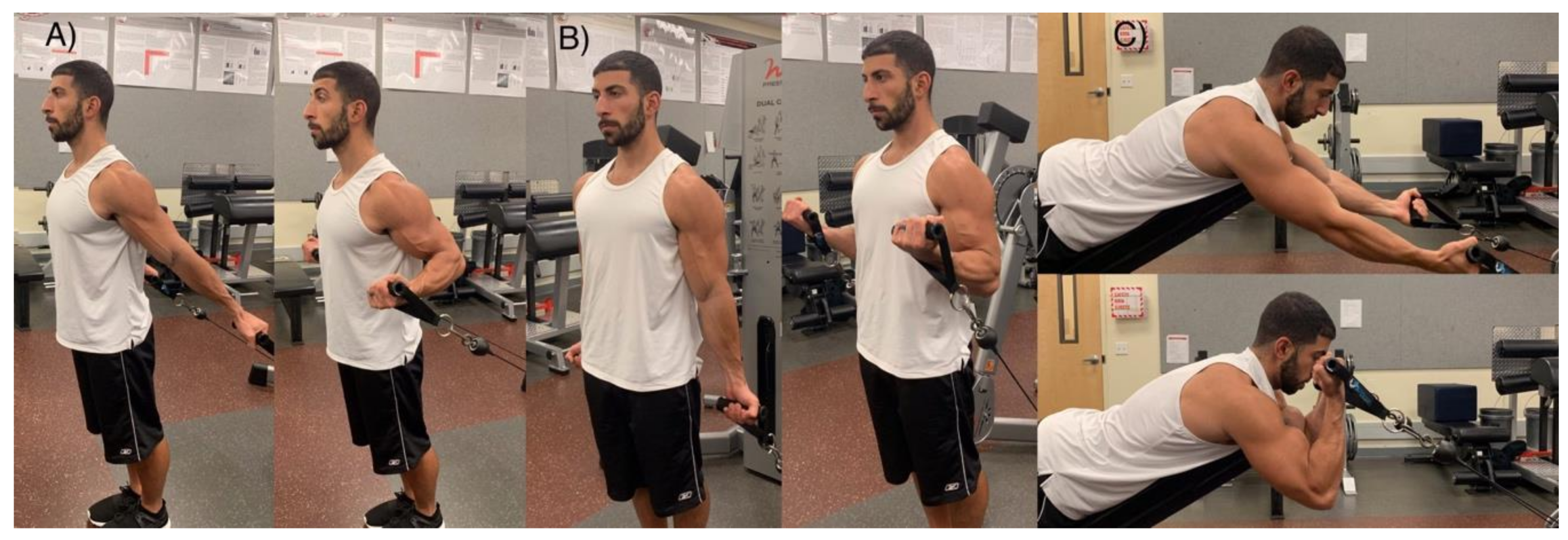
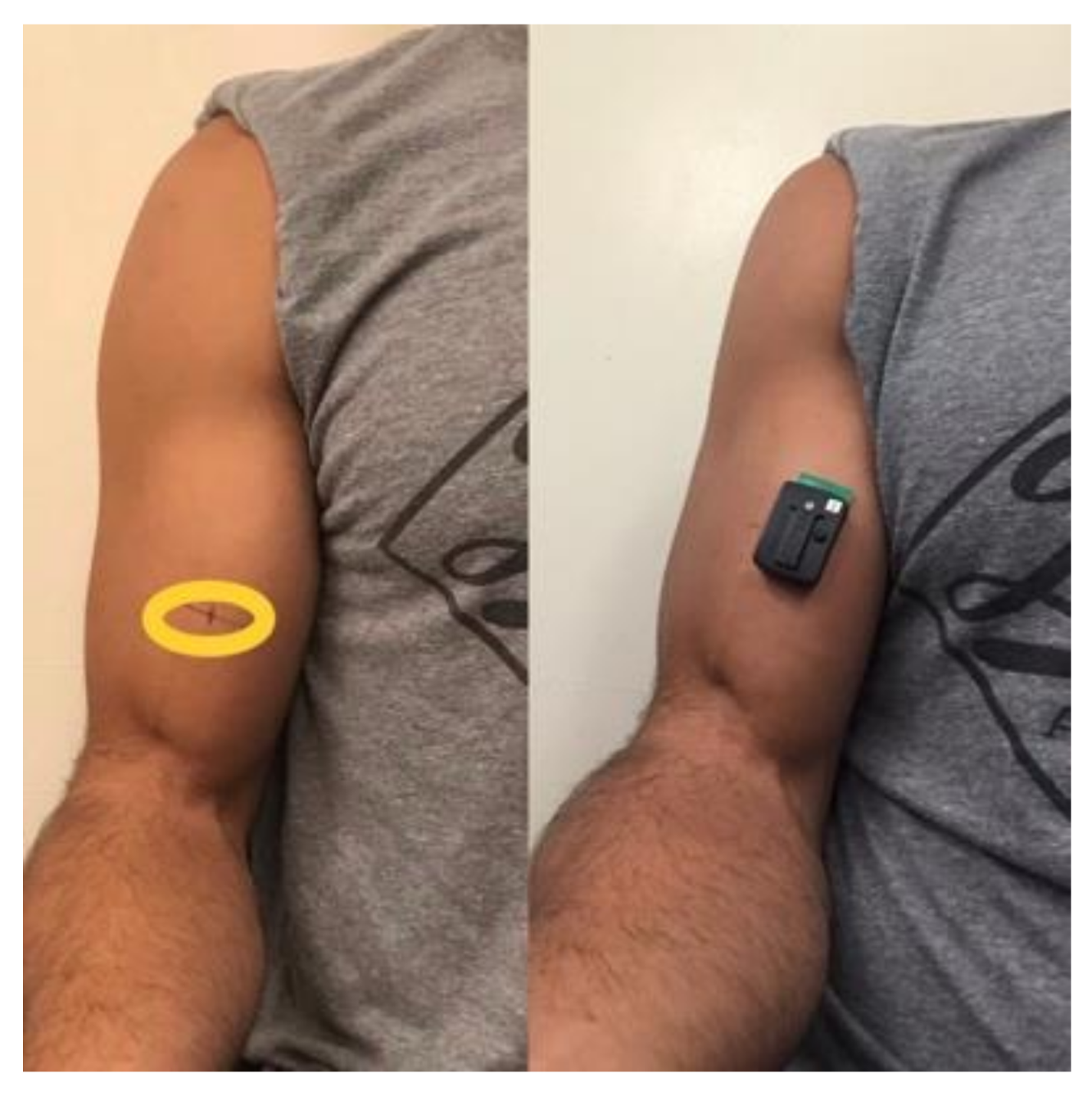
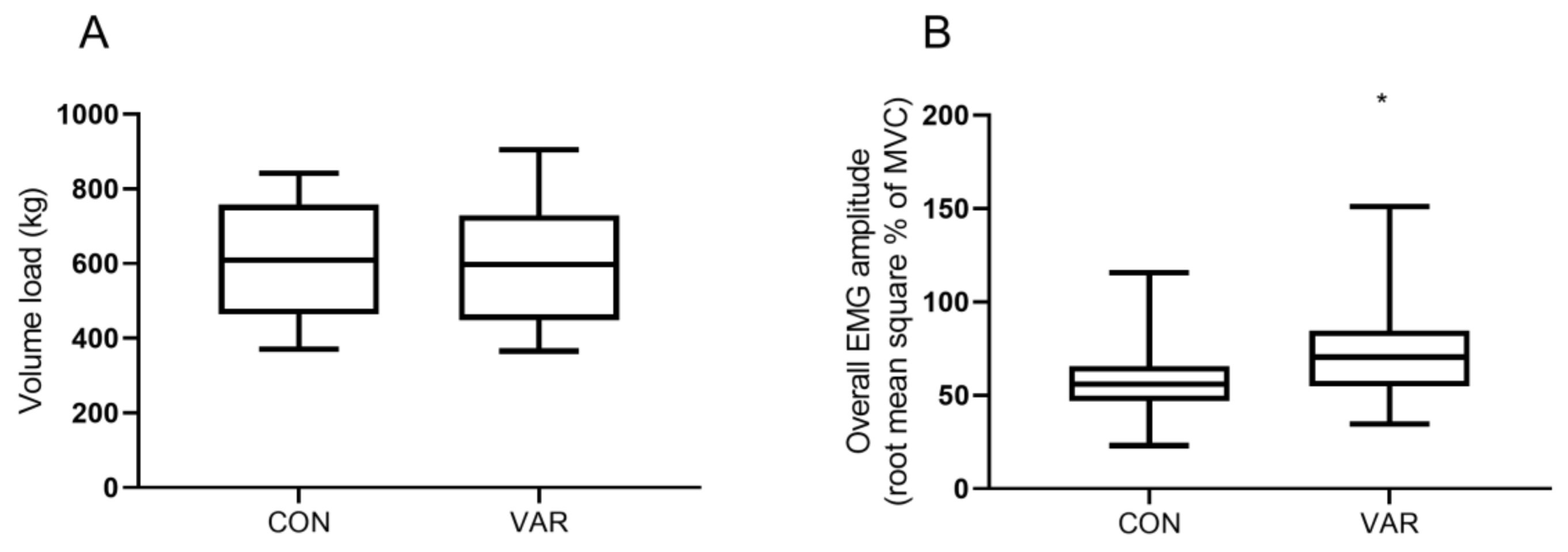
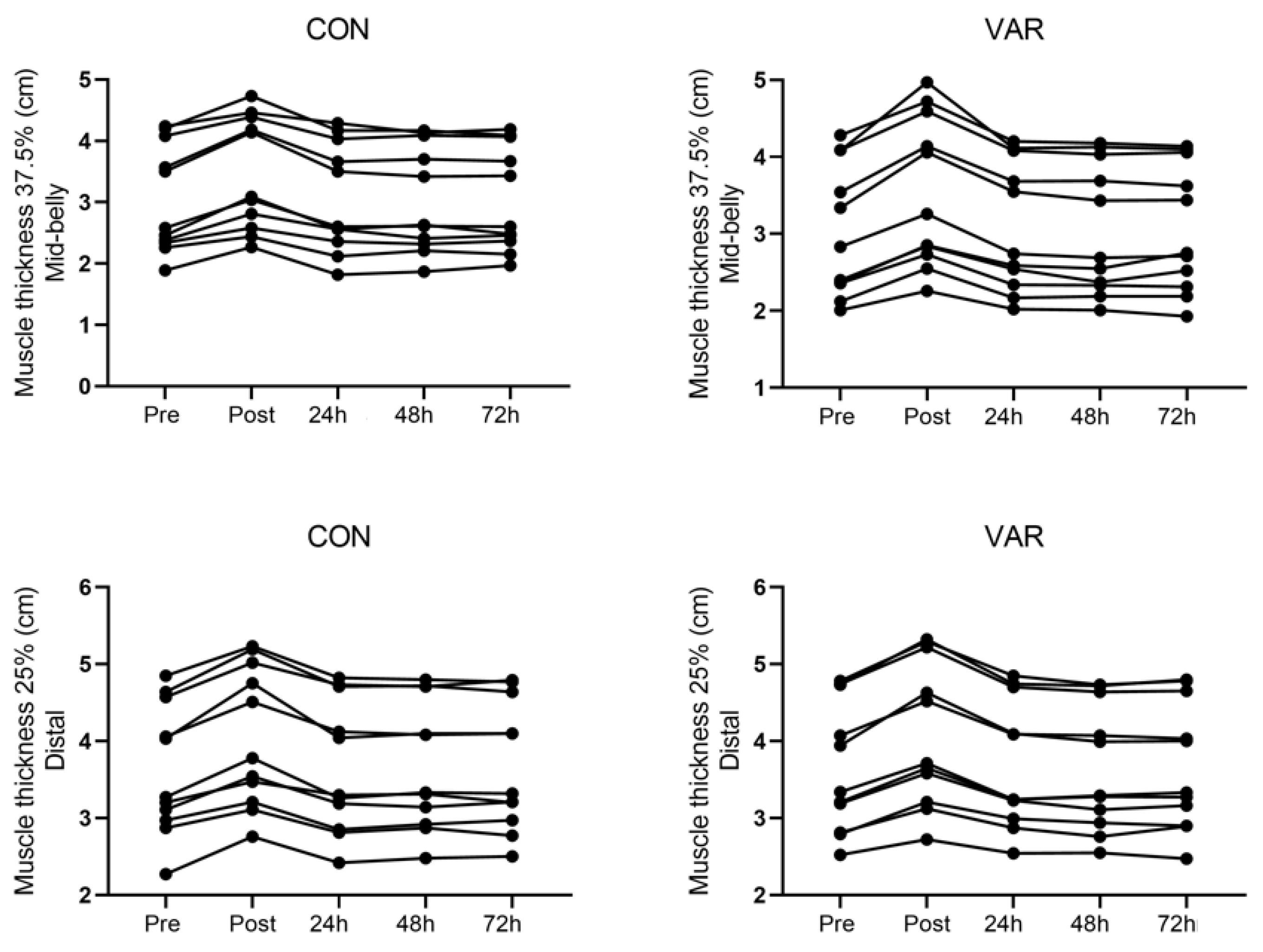
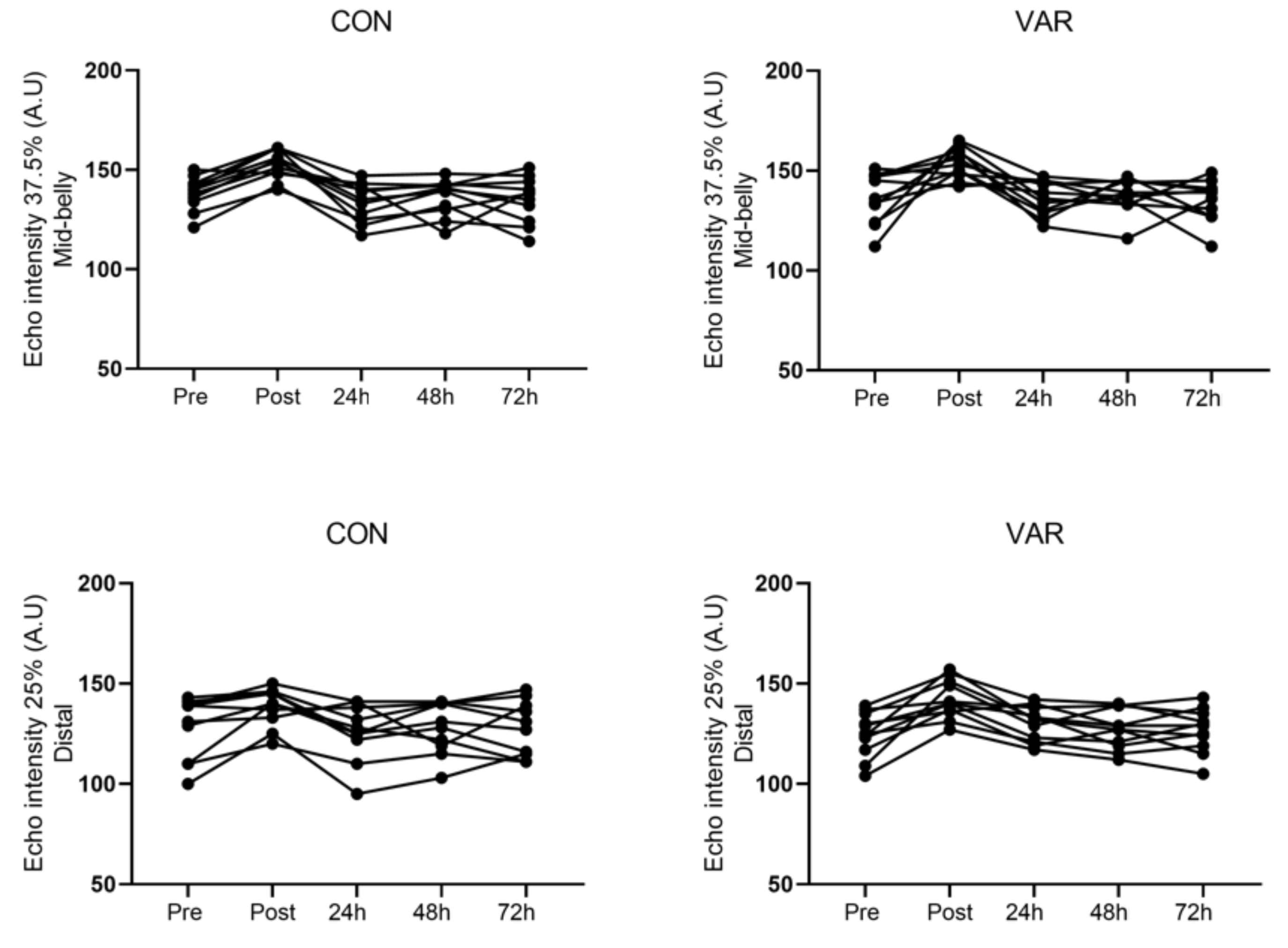
© 2019 by the authors. Licensee MDPI, Basel, Switzerland. This article is an open access article distributed under the terms and conditions of the Creative Commons Attribution (CC BY) license (http://creativecommons.org/licenses/by/4.0/).
Share and Cite
Barakat, C.; Barroso, R.; Alvarez, M.; Rauch, J.; Miller, N.; Bou-Sliman, A.; De Souza, E.O. The Effects of Varying Glenohumeral Joint Angle on Acute Volume Load, Muscle Activation, Swelling, and Echo-Intensity on the Biceps Brachii in Resistance-Trained Individuals. Sports 2019, 7, 204. https://doi.org/10.3390/sports7090204
Barakat C, Barroso R, Alvarez M, Rauch J, Miller N, Bou-Sliman A, De Souza EO. The Effects of Varying Glenohumeral Joint Angle on Acute Volume Load, Muscle Activation, Swelling, and Echo-Intensity on the Biceps Brachii in Resistance-Trained Individuals. Sports. 2019; 7(9):204. https://doi.org/10.3390/sports7090204
Chicago/Turabian StyleBarakat, Christopher, Renato Barroso, Michael Alvarez, Jacob Rauch, Nicholas Miller, Anton Bou-Sliman, and Eduardo O. De Souza. 2019. "The Effects of Varying Glenohumeral Joint Angle on Acute Volume Load, Muscle Activation, Swelling, and Echo-Intensity on the Biceps Brachii in Resistance-Trained Individuals" Sports 7, no. 9: 204. https://doi.org/10.3390/sports7090204
APA StyleBarakat, C., Barroso, R., Alvarez, M., Rauch, J., Miller, N., Bou-Sliman, A., & De Souza, E. O. (2019). The Effects of Varying Glenohumeral Joint Angle on Acute Volume Load, Muscle Activation, Swelling, and Echo-Intensity on the Biceps Brachii in Resistance-Trained Individuals. Sports, 7(9), 204. https://doi.org/10.3390/sports7090204




